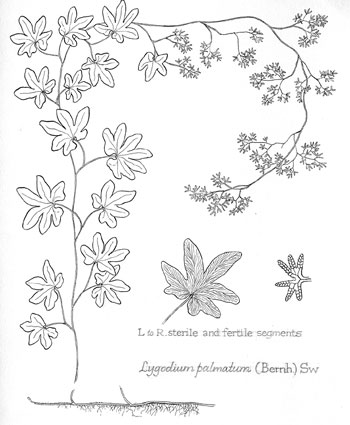|
Hardy Fern Home L. palmatum resources
All Ferns � Lygodiaceae �� Lygodium
�Other Genera
|
| Lygodium palmatum | ||
Hartford fern, American climbing fern | ||
|
Etymology
Palmatum means palmately shaped.
Description
Rhizome: creeping, branching, stipes 1-4 cm apart, short, blackish or red hairs.
Frond: 300 cm high , evergreen, but the fertile pinnae dying back in winter, monomorphic, blade/stipe ratio: 30:1. Stipe: twining, branching, shining black, shading to brown and green above, hairy at base, vascular bundles: 1, a simple cylinder. Blade: 2-pinnate, twining rachis, palmate or pinnate pinnae, transparent hairs on lower surface; a second form in northern areas is glabrous. Pinnae: alternate, sterile pinnae on 1-2 cm stalks, a pair of pinnules very broadly ovate, deeply and palmately 3-7-lobed, to 6 cm; fertile: contracted, always at the end of the frond, irregularly, palmately 3-6-forked or lobed; costae sometimes ridged or winged; segments sterile: ultimate lobes triangular-elongate to oblong; margins entire; veins free, forking. Sori: , indusium: false, scale-like, opening along a longitudinal slit, sporangia: in 2 rows, covering the surface of the ultimate segments, maturity: winter, short viability. Dimensionality: pinnae held horizontally. Culture
Habitat: margins of woods, thickets, and bogs in humus-rich, acid soils, not in shade.
Distribution: eastern United States, rare except in Kentucky, Tennessee.
Hardy to -35�C, USDA Zone 3.
Distinctive Characteristics
twining habit, palmate sterile segments
Synonyms
Gisopteris palmata Bernhardi Ramondia palmata Bosc |
|
|
Notes
Spore Maturity Spore collected in the fall fails to germinate, while winter collection is successful -- J. Mickel, personal communication.
Spore Maturity Spore collected in the fall fails to germinate, while winter collection is successful -- J. Mickel, personal communication.
|
Lygodium palmatum. Habit. �Web pages of the Connecticut Botanical Society, with permission. |
